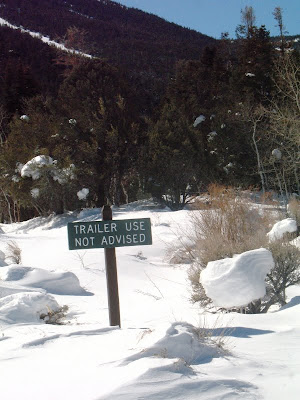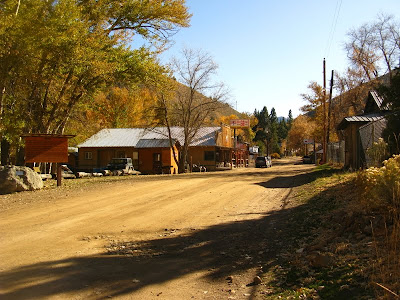I'm sure I've mentioned that we live in a very small house, the place I call "our little house." I've used that phrase with fondness for more than two years, but it seems that the fondness is wearing thin more often than not anymore. Or is it just that winter is here and I have a case of cabin fever?

Notice our recently inherited (found in front of the house) yellow rubber duckie, with walkie talkie and captain's hat. It's sitting mixed in with typical geo stuff, like cupriferous rocks, core, and cholla bones.
Whatever the case may be, in regard to cabin fever, the house is less than 500 square feet - MOH say it's 450 square feet - and that includes an arctic entryway heated only by boot warmers and lit only by a small lamp. Electricity is run into the entryway by way of one or two extension cords.

Besides using the entryway as a place to take off wet, muddy, snowy, or icy boots in winter, we use it as an impromptu, semi-organized, and variably crowded storage area - for stuff like tools and parts, extra towels and blankets, several tarps, boxes of camping miscellany, extra boxes and boxes about to be thrown away, extra house supplies, car and truck maintenance stuff like window de-icer, hiking stuff including fanny packs and hiking sticks, large tools like shovels for ice and snow, salt for large ice masses that accumulate right outside the door, small appliances not currently in use like a crock pot, a few field items like my stash of field teas and my small ice chest, and a folding chair for taking boots on and off. We don't use the room to store much in the way of extra food: daytime temperatures anytime the sun shines (especially in spring, summer, and fall) can be too warm for some things, and nighttime temperatures (in fall, winter, and spring) can be below freezing.
I'm not convinced that there is one ounce of insulation anywhere in this small house. Certainly there isn't any under the floor or on the outer walls of the crawlway beneath the house, where our water lines run unprotected by the winter cold; hence the small space heater we have in the bathroom, designed to protect the pipes, and also designed to protect our feet from the near freezing floors. Likewise, our seven windows are old-style wooden-framed single-pane windows. They don't provide much insulation in summer or winter, and are leaky overall. We could insulate four windows from the inside using the shrink-plastic method. A fifth is quite large and not very accessible from the inside, but could possibly be insulated from the outside. I want to be able to open the remaining two when the house overheats from solar heating (which happens all year long) and when the indoor air gets stale in winter.
This little house has been a good field house - or field office, perhaps - but as permanent living quarters it seems to get smaller and smaller with every passing week. Adding shelves on already crowded walls can add to the already cluttered look, but I've done that in a few places.

The wall above the stove in the kitchen with some miscellaneous items including a small pressure cooker and our brand new, very tiny tea kettle. (Yay!) It boils four cups of water, whistles - although don't go too far away or you won't hear it - and it sometimes needs a potholder because the handle overheats on a gas stove. You can't buy a square potholder in this town - oh, wait, I forgot to check the *other* hardware store - so I use a dish cloth. Just like camping!
The place is crowded because we aren't using it as just a field location anymore; we are living here. We, therefore, seem to want to have on hand (and sometimes need) more things than if this were just a field house or office. I have all of my Nevada publications and maps, lots of my non-digital photos (not all of them), some of my ongoing writing projects, most of my art supplies and some of my paintings, and most of our current and recent financial and tax papers. I won't keep the photo prints or art stuff in our separately rented storage unit for fear of hot and cold temperatures.
We also have quite a bit of seasonal clothing, for use in high summer through deep winter. Some of the extra clothes are in the storage unit, some clothes are in bins under beds, and some clothes get taken back and forth, to and from the lake - though the back and forth happens less often now that we live here. We also have quite a number of books, and more magazines than I like to contemplate. These all get sorted and re-sorted, stacked and re-stacked, with many going back to the lake when the opportunity arises. I'm seriously considering canceling almost all print magazines.
I was saying earlier that I doubt there is much of any insulation in this house. Was any new insulation put into the walls whenever the walls were re-paneled? I don't know. Maybe. The wall paneling could be several decades old but is much younger than the house, which would be a 1940's house at the youngest, and possibly much, much older. Maybe any original insulation - newspapers or other cellulose - was taken out when the "new" paneling was put in, or maybe it has just settled very badly.

And don't get me started about the wiring! At some point, receptacles were changed from the old-style two-prong receptacles to the newer three-prong in a few places: on some interior walls and in the kitchen and bathroom. I don't know if these are grounded circuits, or if they just look that way. And as far as I can tell, none of these three prongers have built-in GFI or GFCI circuit breakers, so we have added a plug-in GFCI breaker in the bathroom.
NOTE: Originally written in early November.
 The last sunset, looking east, with magnificent wave clouds above and behind the Schell Creek and Duck Creek Ranges.
The last sunset, looking east, with magnificent wave clouds above and behind the Schell Creek and Duck Creek Ranges. The last sunset, looking west, with our hiking hill barely in view at the bottom of the photo.
The last sunset, looking west, with our hiking hill barely in view at the bottom of the photo. The last birds: a couple of juncos braving the cold evening, despite a relatively empty bird feeder.
The last birds: a couple of juncos braving the cold evening, despite a relatively empty bird feeder. Certainly not the last icicles of the winter!
Certainly not the last icicles of the winter! The last full moon - a blue moon - not an eclipsed moon in this locale.
The last full moon - a blue moon - not an eclipsed moon in this locale.











































